- Submissions

Full Text
Modern Approaches in Drug Designing
Assessment of In-vitro Anti-Inflammatory Activity of Cynodon Dactylon and Acyclovir Showing Synergistic Effect by Albumin Denaturation and Membrane Stabilization Assay
Suchita V Ghumre1*, Mrunal G Sawant2, Varsha M Jadhav1, Vilasrao J Kadam1, Nilam Sonawane2 and Mira Ramaiya2
1Bharati Vidyapeeth’s College of Pharmacy, Indiay
2Haffkine Institute, India
*Corresponding author: Suchita Vishnu Ghumre, Department of Quality Assurance, Bharati Vidyapeeth’s College of Pharmacy C.B.D Belapur, Navi Mumbai-400614, Maharashtra, India
Submission: September 08, 2017; Published: October 26, 2017

ISSN : 2576-9170Volume1 Issue2
Abstract
The present research was carried out the evaluation of the anti-inflammatory property of methanolic extract of Cynodon dactylon and Acyclovir as individual and in combination by two different methods viz., Albumin denaturation assay and Membrane stabilization assay. Ten different concentration of Cynodon dactylon methanolic extract and Acyclovir solution (100, 200, 300, 400,500, 600, 700, 800, 900, 1000mg) were using in these studies. Antiinflammatory action was observed in dose dependent manner. In protein denaturation method at concentration of 1000ppm extract showed maximum protection (82.46%) and standard drug provided (73.23%) protection where as concentration of 500ppm acyclovir showed maximum protection (28.94%). The combination of both i.eat 1000ppm of extract and 500ppm of acyclovir showed maximum protection at the ratio of 80:20 (84.76%). Similarly, in membrane stabilization test, the selected extract at concentration of 1000ppm showed maximum membrane stabilization (89.1%) and standard drug provided (78.44%) protection, acyclovir showed maximum protection at concentration of 500ppm (28.62%).The combination of both i.e. at 1000ppm of extract and 500ppm of acyclovir showed maximum protection at the ratio of 80:20 (91.49%).Hence, from these results, we concluded that methanolic extract of Cynodon dactylon methanolic extract and acyclovir shows synergistic effect at different concentration when compared to standard NSAID drug (Diclofenac sodium). In addition, phytochemical analysis of Cynodon dactylon methanolic extract showed the presence of alkaloids, carbohydrates, flavonoids, glycosides, proteins, phytosterol etc. It reveals that these phytochemical constituents are responsible to maximum protection of protein denaturation and albumin denaturation and membrane stabilization assay.
Keywords: Cynodon dactylon extract; Acyclovir; Albumin denaturation; Membrane stabilization; Phytochemical analysis
Introduction
Denaturation of tissue proteins and lysis of RBC membrane are well documented causes of inflammatory diseases. Production of auto antigens in certain inflammatory diseases may be due to denaturation of proteins or lysis of RBC membrane in-vivo. The in-vitro anti-inflammatory effect of individual extracts and in combination was evaluated against denaturation of egg albumin and membrane stabilization of RBC. The present findings exhibited a concentration dependent inhibition of protein (albumin) denaturation by the extracts throughout the selected concentration ranges. The increments in absorbance of test samples with respect to control indicated stabilization of protein i.e. inhibition of heatinduced protein (albumin) denaturation by extracts and reference drug diclofenac sodium. From the IC 50 values it becomes evident that the extracts were more active than diclofenac sodium, being effective in lower concentrations. This anti-denaturation effect was further supported by the change in viscosities. It has been reported that the viscosities of protein solutions increase on denaturation. In the present study, the relatively high viscosity of control dispersion substantiated this fact [1].
During inflammation, there are lyses of lysosomes which release their component enzymes that produce a variety of disorders. Non-steroidal anti-inflammatory drugs (NSAIDs) exert their beneficial effects by either inhibiting the release of lysosomal enzymes or by stabilizing the lysosomal membranes. Exposure of red blood cells (RBCs) to injurious substances such as hypotonic medium, heat, methyl salicylate or phenyl hydrazine results in the lysis of the membranes, accompanied by haemolysis and oxidation of haemoglobin [2]. Since human red blood cell (RBC) membranes are similar to lysosomal membrane components, the inhibition of hypotonicity and heat induced red blood cell membrane lysis was taken as a measure of the mechanism of anti-inflammatory activity of Cynodon dactylon extract with diclofenac sodium as a standard. The haemolytic effect of hypotonic solution is related to excessive accumulation of fluid within the cell resulting in the rupturing of its membrane. Injury to red cell membrane will render the cell more susceptible to secondary damage through free radical induced lipid peroxidation. Membrane stabilization leads to the prevention of leakage of serum protein and fluids into the tissues during a period of increased permeability caused by inflammatory mediators. The results showed that Cynodon dactylon extract, which perhaps stabilized the red blood cell membrane by preventing the release of lytic enzymes and active mediators of inflammation [3].
Experimental
Materials and Methods
Plant material: The plant material (leaves) was collected from local market and was authenticated by Dr H. M Pandit, Khalsa College, Matunga. The fresh leaves were washed under running tap water to remove adhere dirt, followed by rinsing with distilled water, shade dried and pulverised in a mechanical grinder to obtain coarse powder.
Extraction of Bioactive Components: 10 gram of powdered drug (Cynodon dactylon) was weighed and extracted with methanol as solvent using soxhlet apparatus for 24hrs. The process was repeated three times using the same solvent. The extracts were dried under desiccators and the percentage yield was calculated. The methanolic extract was used for the preliminary phytochemical investigation, anti-inflammatory activity [4].
In Vitro Anti-Inflammatory Activity
Inhibition of albumin denaturation
The 5ml of reaction mixture was comprised of 0.2ml of eggs albumin, 2.8ml of phosphate buffered saline (PBS, pH 6.4) and 2ml of varying concentration of extracts. Similar volume of double distilled water served a control. Then the mixture was incubated at 37 °C in incubator for about 15mins and then heated at 70 °C for 5mins. After cooling, their absorbance was measured at 660nm by using pure blank. Diclofenac sodium (standard drug) was used as reference drug and treated as such for determination of absorbance. The percentage inhibition of protein denaturation was calculated by the formula mentioned below.

Membrane Stabilization Property
Preparation of Red Blood Cells (RBCs) suspension
Fresh whole human blood (10ml) was collected and transferred to the heparinzed centrifuged tubes. The tubes were centrifuged at 3000rpm for 10min and were washed three times with equal volume of normal saline. The volume of the blood was measured and reconstituted as 10%v/v suspension with normal saline [5].
Heat Induced haemolysis
The 2ml reaction mixture is consisted of 1ml of test extract at various concentrations and 1ml of 10% RBCs suspension, instead of drug only saline was added to the control test tube. Diclofenac sodium was taken as a standard drug. All the centrifuged tubes containing reaction mixture were incubated in a water bath at 560C for 30min. At the end of the incubation, the tubes were cooled under running tap water. The reaction mixture was centrifuged at 2500rpm for 5min and the absorbance of the supernatants was taken at 560nm [6]. The experiment was performed in triplicate. % of membrane stabilization activity was calculated by the formula mentioned below:

Phytochemical analysis
The dried powdered samples were subjected to qualitative tests for the identification of phytochemical constituents according to standard procedures.
Results and Discussion
Figure 1: Graph showing % inhibition of protein denaturation activity of Cynodon dactylon extract.

Figure 2: Graph showing % inhibition of protein denaturation activity of acyclovir.
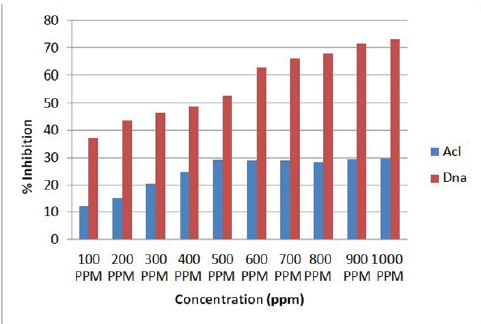
In the present investigation, the in vitro anti-inflammatory effect of Cynodon dactylon and Acyclovir as individual and Cynodon dactylon extract and acyclovir in combination was evaluated against denaturation of egg albumin and Membrane stabilization method [7]. The results are summarized below. The present findings revealed a concentration dependent inhibition of protein (albumin) denaturation and Membrane stabilization method by Cynodon dactylon, Acyclovir as individual and Cynodon dactylon extract and acyclovir in combination throughout the concentration range of 100 to 1000μg/ml. Diclofenac sodium (at the concentration range of 100 to 1000μg/ml) was used as reference drug which also exhibited concentration dependent inhibition of protein denaturation; nonetheless, the effect of diclofenac sodium was found to be less compared to Cynodon dactylon extract as well as in combination of Cynodon dactylon extract and Acyclovir (Table 1-6) (Figure 1-4).
Table 1: Effect of Cynodon dactylon extract on protein Denaturation.
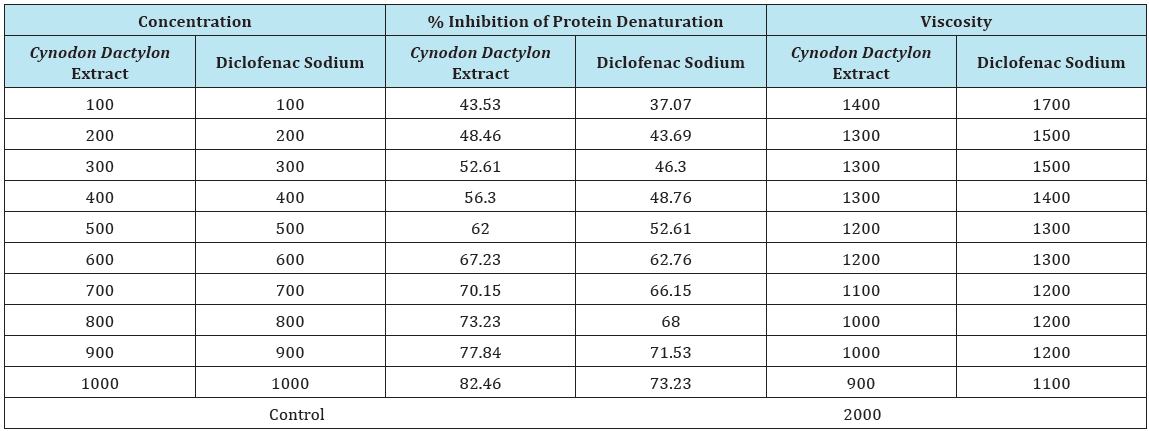
All values are mean ± S.D (NMT 2%).
Table 2: Effect of acyclovir on protein denaturation.
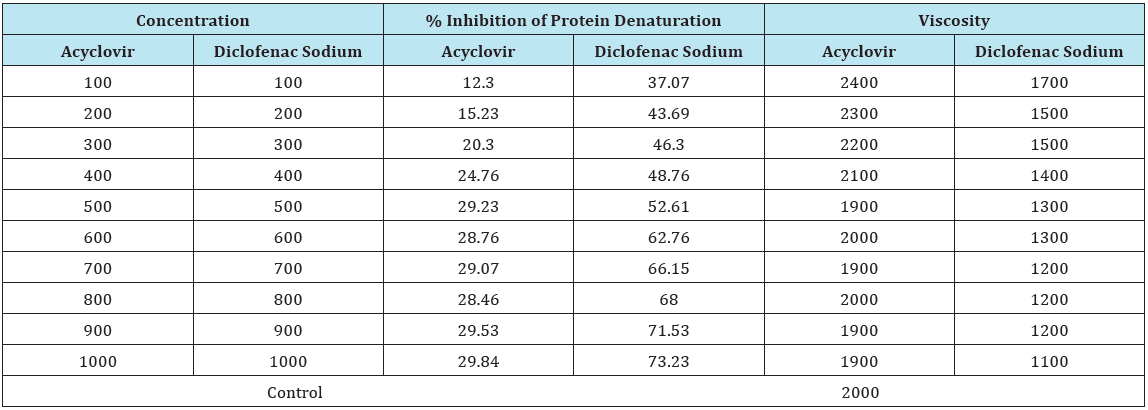
All values are mean ± S.D (NMT 2%).
Table 3: % inhibition of protein denaturation activity of combination of extract and acyclovir.

All values are mean ± S.D. (NMT 2%).
Table 4: Effect of Cynodon dactylon extract on membrane stabilization.
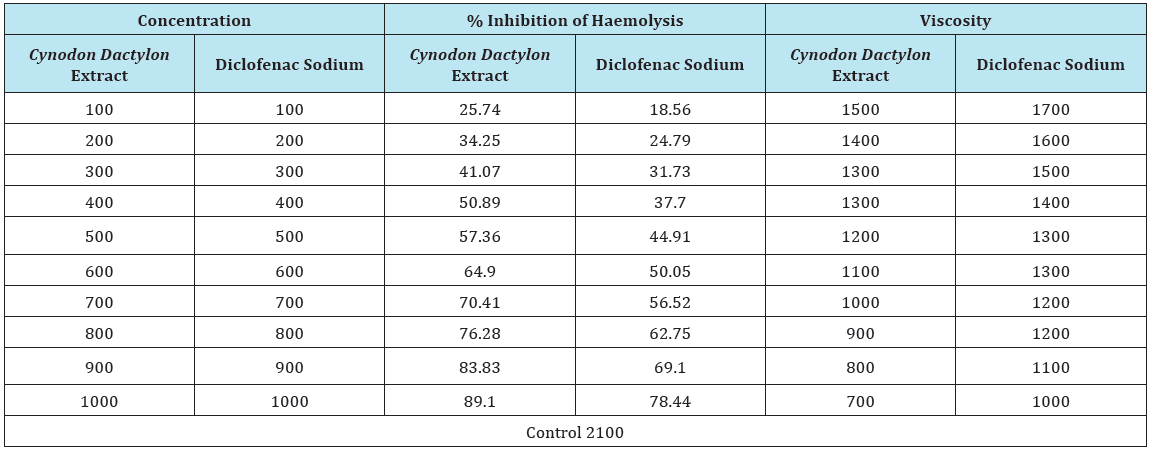
All values are mean ± S.D (NMT 2%).
Table 5: Effect of acyclovir on membrane stabilization.

All values are mean ± S.D (NMT 2%).
Table 6: Effect of combination of extract and acyclovir on membrane stabilization.

All values are mean ± S.D. (NMT 2%).
Figure 3: Graph showing % inhibition of haemolysis activity of Cynodon dactylon extract
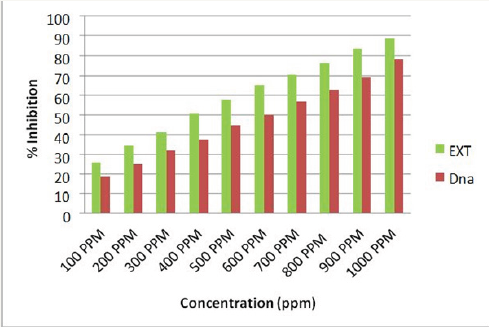
Figure 4: Graph showing % inhibition of haemolysis activity of Cynodon dactylon extract

Protein denaturation test showed highest % inhibition found at concentration ratio of extract (1000ppm): acyclovir (500ppm) [80:20v/v] and membrane stabilization test highest % inhibition of haemolysis found at concentration ratio of extract (1000ppm): acyclovir (500ppm) [80:20v/v] [8].
Table 7: Results of qualitative phytochemical tests.
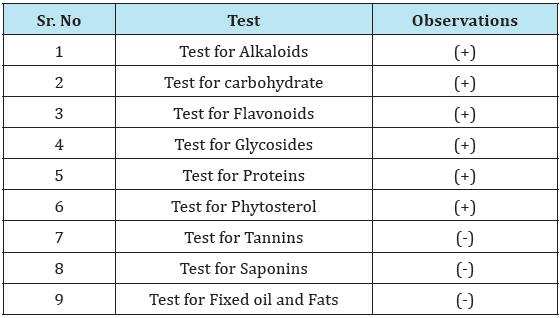
(+): Presence; (-): Absence.
In addition that, dried powdered samples were subjected to qualitative tests for the identification of phytochemicals constituents according to standard procedures. The preliminary phytochemical investigation showed the presence of phyto constituents such as alkaloids, carbohydrates, flavonoids, glycosides, proteins, phytosterol were observed in Cynodon dactylon methanolic extract (Table 7).
So from the results of our study reveals that extract of Cynodon dactylon and Acyclovir in combination at the ratio 80:20 are capable of control the inhibition of denaturation of albumin and membrane lysis in rheumatic disease. Our present studies indicate that extract and acyclovir in combination exhibits strong anti-inflammatory property could be potential source of antiinflammatory property. The inhibition of albumin denaturation and membrane stabilization was studied to establish the mechanism of anti-inflammatory activity of Cynodon dactylon and Acyclovir in combination showing synergistic effect. Therefore, our in vitro studies on extract of Cynodon dactylon demonstrate the significant anti-inflammatory activity. The results show that the extracts of Cynodo dactylon exhibited anti-inflammatory activities might be due to the presence of active principles such as polyphenolic content, alkaloids and flavonoids [9]. From the results of the study, it can be concluded extract of Cynodon dactylon and Acyclovir in combination possessed anti-inflammatory property.
Acknowledgement
Authors are thankful to Manish Pharmaceutical Ltd. for providing gift samples of Acyclovir. We are highly grateful to Bharati Vidyapeeth’s college of pharmacy, CBD Belapur, Navi Mumbai and Haffkine institute, Parel, Mumbai for the collaborative project and allowing the use of laboratory facilities to carry out the research work. I whole heartedly thank my colleague Mr. Aditya D. Ghuge for his timely help with kind suggestions throughout the research work.
References
- Vadivu R, Lakshmi KS (2008) In vitro and in vivo anti-inflammatory activity of leaves of Symplocos cochinchnensis (Lour) Moore ssp laurina. Bangladesh Journal of Pharmacology 3(2): 121-124.
- Lee SJ, Chinen J, Kavanaugh A (2010) Immunomodulator therapy: monoclonal antibodies, fusion proteins, cytokines, and immunoglobulins. J Allergy Clin Immunol 125(2 Suppl 2): S314-S323.
- Mythilypriya R, Shanthi P, Sachdanandam P (2008) Efficacy of Siddha formulation Kalpaamruthaa in ameliorating joint destruction in rheumatoid arthritis in rats. Chem Biol Interact 176(2-3): 243-251.
- Berbert AA, Kondo CRM, Almendra CL, Matsuo T, Dichi I (2005) Supplementation of fish oil and olive oil in patients with rheumatoid arthritis. Nutrition 21(2): 131 -136.
- Umapathy E, Ndebia EJ, Meeme A, Adam B, Menziwa P, Chungag BNN, et al. (2010) An experimental evaluation of Albuca setosa aqueous extract on membrane stabilization, protein denaturation and white blood cell migration during acute inflammation. Journal of Medicinal Plants Research 4(9): 789-795.
- Chaudhary J, Garland WA (2012) Chemical inhibitors of inhibitors of differentiation. Google Patents.
- Sostres C, Gargallo CJ, Lanas A (2013) Nonsteroidal anti-inflammatory drugs and upper and lower gastrointestinal mucosal damage. Arthritis Res Ther (15 Suppl 3): S3.
- Dhikav V, Singh S, Pande S, Chawla A, Anand KS (2003) Non-steroidal drug-induced gastrointestinal toxicity: mechanisms and management. J Indian Acad Clin Med 4(4): 315 -322.
- Kokate CK, Purohit AP, Gokhale SB (2010) Pharmacognosy. Niraliprakashan, Pune, India, 3: 3.70-3.71.
© 2017 Suchita V Ghumre, et al. This is an open access article distributed under the terms of the Creative Commons Attribution License , which permits unrestricted use, distribution, and build upon your work non-commercially.
 a Creative Commons Attribution 4.0 International License. Based on a work at www.crimsonpublishers.com.
Best viewed in
a Creative Commons Attribution 4.0 International License. Based on a work at www.crimsonpublishers.com.
Best viewed in 







.jpg)






























 Editorial Board Registrations
Editorial Board Registrations Submit your Article
Submit your Article Refer a Friend
Refer a Friend Advertise With Us
Advertise With Us
.jpg)






.jpg)














.bmp)
.jpg)
.png)
.jpg)










.jpg)






.png)

.png)



.png)






